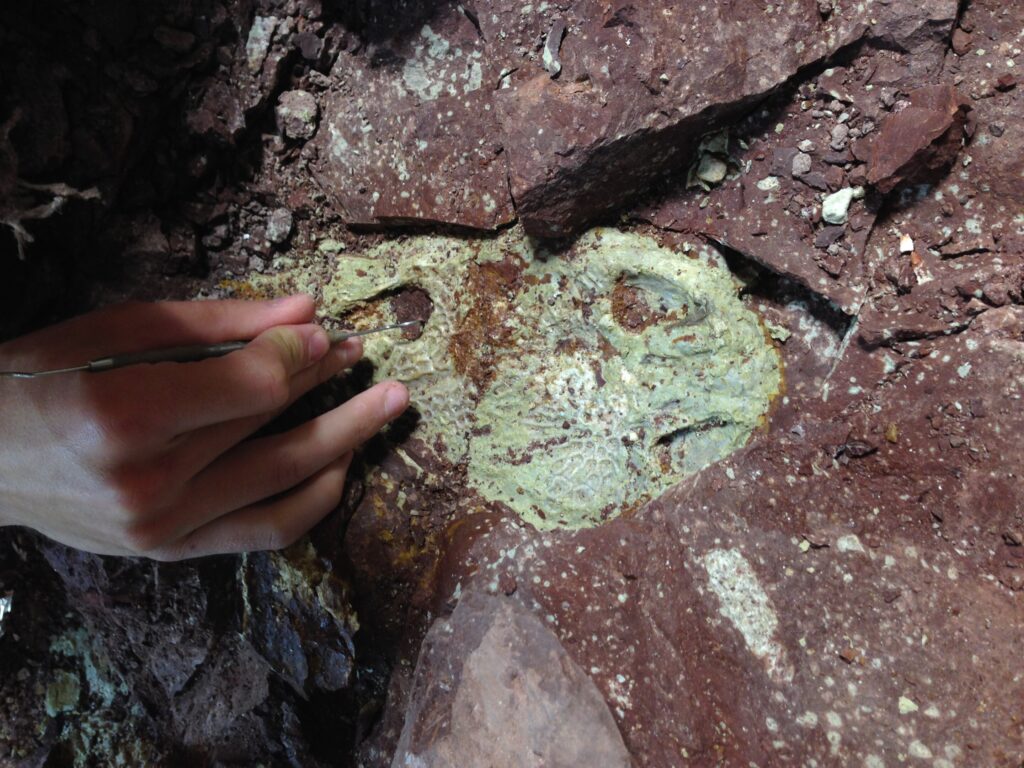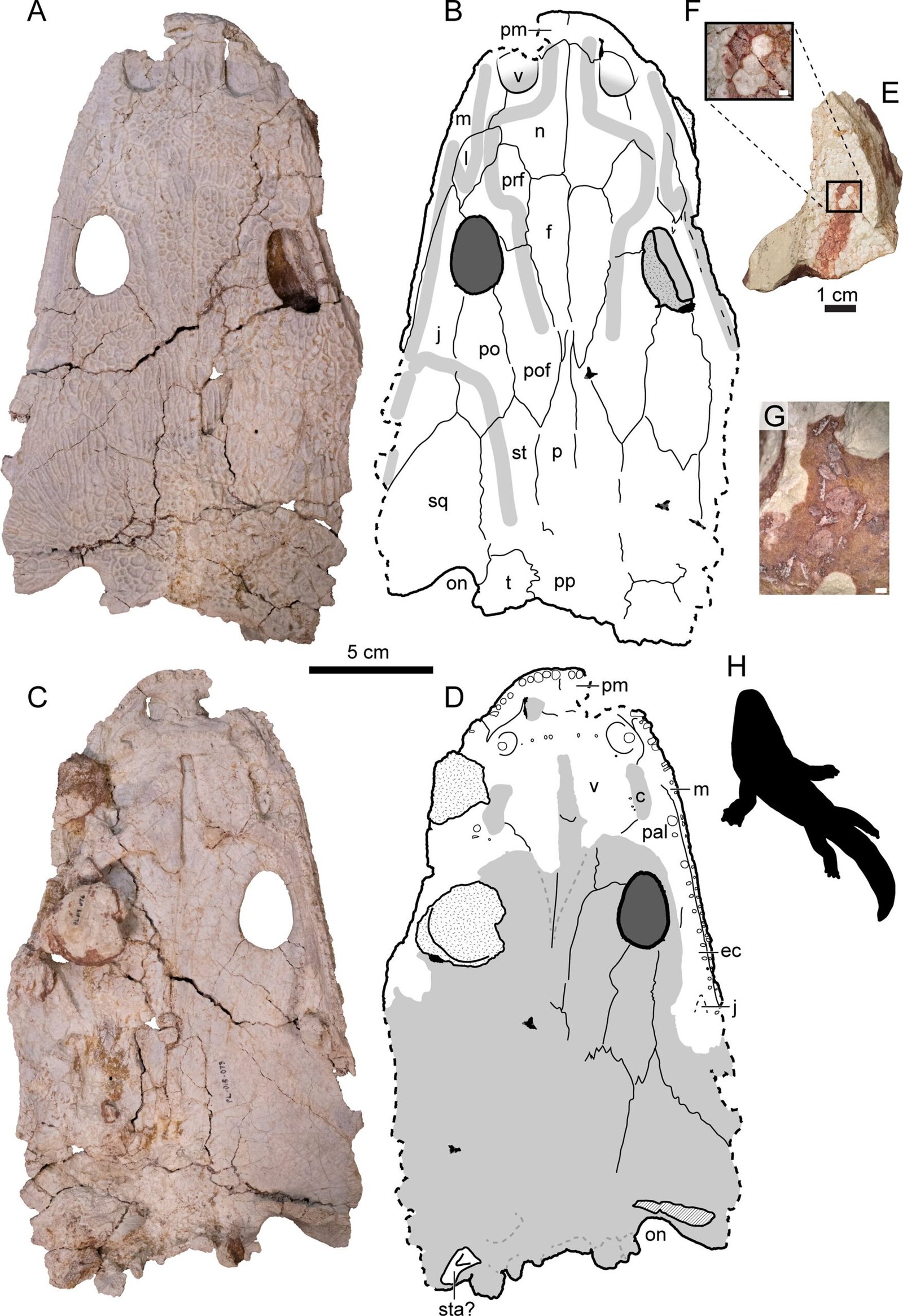In the ancient floodplains of Wyoming, approximately 230 million years ago, a remarkable event unfolded that would later leave behind a fossilized record of mass death. The evidence of this event was uncovered by researchers in a study published in the open-access journal PLOS One, led by Aaron M. Kufner of the University of Wisconsin-Madison, and colleagues. Their investigation provides new insights into the lives and deaths of ancient amphibians known as metoposaurid temnospondyls, shedding light on an unusual moment in the Early Age of Dinosaurs.
The study focuses on the Nobby Knob site in Dubois, Wyoming, a significant fossil bed where a large concentration of fossilized remains of an extinct species, Buettnererpeton bakeri, was found. These creatures, resembling alligators in size, roamed freshwater habitats during the Late Triassic period. Today, this site offers an exceptional opportunity for paleontologists to explore the circumstances surrounding an ancient, large-scale die-off of these amphibians.
A Floodplain of Tragedy: Metoposaurid Amphibians and Their Habitat
During the Age of Dinosaurs, the Earth was a vastly different place. The dominant animals were not the reptiles we associate with the word “dinosaurs” today, but rather a range of other extraordinary creatures, including giant amphibians. Among the most interesting and formidable creatures were the metoposaurid temnospondyls. These were large, semi-aquatic amphibians that grew to the size of modern-day alligators, some species reaching lengths of up to 10 feet or more.
The metoposaurids lived in freshwater environments, thriving in ancient lakes, rivers, and floodplains. These amphibians were formidable predators, preying on smaller creatures that shared their watery habitats. Fossil evidence of metoposaurids is common in sites around the world, often in large bonebeds where hundreds or even thousands of individuals appear to have perished together. However, understanding how these massive concentrations of fossils came to be has long been a subject of mystery.
Typically, fossil sites that contain such large concentrations of remains can be difficult to interpret. Was this a single event, or did these animals die over a prolonged period? Were they all buried at once, or was their burial a slow and gradual process? These questions are difficult to answer, especially when the conditions surrounding fossilization are not well understood.
The Nobby Knob Fossil Bed: A Closer Look at the Mass Mortality Event
The fossil site at Nobby Knob, in Wyoming, provides a unique window into the past. Here, the fossilized remains of Buettnererpeton bakeri—a species of metoposaurid temnospondyl—were discovered. What sets this discovery apart from similar fossil beds is the level of detail in the study conducted by Kufner and his team.
The fossils found at Nobby Knob date to approximately 230 million years ago, during the Late Triassic period. This was a time when dinosaurs were just beginning to evolve, and the Earth was transitioning from an earlier era dominated by reptiles like temnospondyls to one that would be defined by the dinosaurs. The fossils found here were carefully studied by Kufner and his colleagues to assess how and why these creatures perished.

The fossil site itself consists of finely layered sediments, which suggest that the remains were buried in an environment that was calm and undisturbed by strong water currents. This was a crucial finding—many other fossil beds contain evidence of turbulent waters, with bones transported from their original locations. In contrast, the bones at Nobby Knob appear to have been buried where they died, indicating that they were likely trapped in place by a sudden environmental event, such as a flood or drought.
Fine-grained ancient soils and the preservation of even delicate skeletal parts point to an environment with very calm water. The lack of strong current action means that the bones were not scattered by moving water, a key observation that suggests the fossils were preserved in their original positions rather than being swept from their place of death.
Why Were These Amphibians Gathered Here?
One of the most intriguing aspects of the Nobby Knob fossil assemblage is the question of why such a large group of metoposaurid amphibians died together. Kufner and his team propose that the amphibians may have been concentrated in this area for a few possible reasons.
First, the Nobby Knob floodplain may have been a breeding ground for Buettnererpeton bakeri. Breeding colonies of animals often gather in specific locations, and these sites can sometimes become areas of mass mortality if the animals become trapped by sudden environmental changes. The site’s calm waters, which allowed for excellent preservation of the remains, might have been a safe haven for the amphibians to gather in large numbers. However, once drought or another environmental disruption occurred, the animals may have become stranded, leading to their eventual death and burial.
Alternatively, the fossil concentration could be a result of restricted water channels, such as narrow riverbeds or streams, which may have dried up during a particularly hot or dry period. This kind of environmental stress could have caused the amphibians to become concentrated in one location, where they were eventually overwhelmed by the conditions and buried by sediment from a sudden flooding event.
Whatever the cause, the mass mortality at Nobby Knob provides valuable insight into the behavior of these early amphibians. The fact that this site represents more than 50% of the known fossils of Buettnererpeton bakeri makes it one of the most significant fossil assemblages of this species. It is an extraordinary opportunity to study the life and death of a single population, providing scientists with a better understanding of how these creatures lived and died during the Late Triassic period.
The Significance of Nobby Knob for Future Research
The Nobby Knob fossil site offers a rare and exciting opportunity for paleontologists to study Buettnererpeton bakeri and other metoposaurids in unprecedented detail. Given that this fossil bed contains so many well-preserved remains, it presents an excellent opportunity to learn more about the biology, behavior, and ecology of these ancient creatures.
The site also raises important questions about the mass mortality events that have been recorded at other fossil sites. Most bonebeds containing metoposaurids represent accumulations of bones that have been transported from their original resting places. These bones were often scattered by strong currents or other disruptive forces. In contrast, the Nobby Knob site is unique because it appears to contain remains of animals that died and were buried together in the same location, with no evidence of movement by water currents.
Kufner and his team suggest that more detailed studies of other fossil sites could help reveal whether mass die-offs like the one at Nobby Knob were common among temnospondyls or other prehistoric amphibians. The examination of other mass mortality beds, using the same rigorous methods employed at Nobby Knob, could reveal new information about how ancient ecosystems responded to environmental stresses and what factors led to the death and preservation of these ancient creatures.
In addition to studying the cause of death, researchers also hope to learn more about the behavior of Buettnererpeton bakeri and other metoposaurids. The bones at Nobby Knob could provide valuable information about how these amphibians lived, what they ate, and how they interacted with each other and their environment.
Conclusion: Unlocking the Secrets of the Past
The discovery and detailed study of the Nobby Knob fossil site offers a rare glimpse into a dramatic and mysterious event that unfolded 230 million years ago. The mass mortality of Buettnererpeton bakeri—an ancient alligator-sized amphibian—provides a unique opportunity to explore the biology, ecology, and behavior of an early vertebrate species in a way that few other fossil sites can offer.
The study conducted by Kufner and his team at the University of Wisconsin-Madison highlights the importance of thorough, systematic excavation and data collection at fossil sites. It underscores the potential for new discoveries in the study of mass mortality events and emphasizes the need for further research into how environmental changes, such as droughts or floods, may have shaped the lives of ancient creatures.
As paleontologists continue to investigate the Nobby Knob site, they will undoubtedly uncover even more secrets from the distant past, expanding our understanding of the ecosystems and lifeforms that existed long before the rise of the dinosaurs. With each new discovery, we move one step closer to understanding the rich and complex history of life on Earth.
Reference: Kufner AM, et al. A new metoposaurid (Temnospondyli) bonebed from the lower Popo Agie Formation (Carnian, Triassic) and an assessment of skeletal sorting, PLOS One (2025). DOI: 10.1371/journal.pone.0317325
